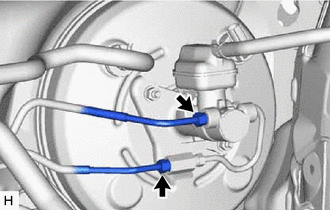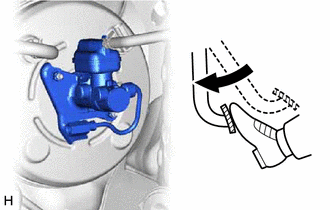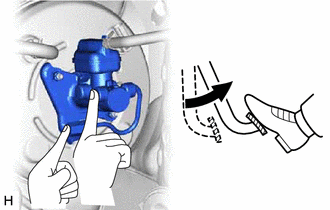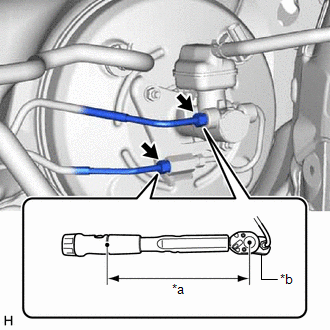Lexus RX (RX 350L, RX450h) 2016-2026 Repair Manual: Bleeding
BLEEDING
CAUTION / NOTICE / HINT
NOTICE:
- Move the shift lever to P and apply the parking brake before bleeding the brakes.
- Add brake fluid to keep the level between the MIN and MAX lines of the reservoir while bleeding the brakes.
- If brake fluid leaks onto any painted surface, immediately wash it off.
- Do not operate the brake actuator assembly while air is in the brake system or in the brake master cylinder sub-assembly. Doing so may cause air to enter the brake actuator assembly.
-
When bleeding air, select the suitable procedure listed below.
Replaced/Installed Item
Work Procedure
Flexible hose (front/rear)
Bleed brake line
Disc brake cylinder assembly (front/rear)
Brake actuator assembly
Bleed brake system
Brake master cylinder sub-assembly
Brake master cylinder reservoir assembly
Brake booster assembly
PROCEDURE
1. BLEED BRAKE LINE
| (a) Remove the brake master cylinder reservoir filler cap assembly. |
|
(b) Add brake fluid to keep the level between the MIN and MAX lines of the reservoir while bleeding the brakes.
Brake Fluid:
SAE J1703 or FMVSS No. 116 DOT3
NOTICE:
- Make sure that there is sufficient brake fluid in the reservoir.
- Do not remove the filter from the brake master cylinder reservoir assembly and be sure to fill the brake master cylinder reservoir assembly with new brake fluid to avoid any potential contamination of the brake system. Contamination, for example by dirt particles or mineral oil, could lead to functional brake problems.
(c) Remove the bleeder plug cap.
(d) Connect the vinyl tube to the bleeder plugs.
(e) Depress the brake pedal several times, and then loosen the bleeder plug with the pedal depressed.*1
NOTICE:
Add fluid as necessary so that the fluid in the reservoir does not decrease below the MIN level.
(f) When fluid stops coming out, tighten the bleeder plug, and then release the brake pedal.*2
(g) Repeat *1 and *2 until all the air in the brake fluid is completely bled out.
(h) Tighten the bleeder plug completely.
Torque:
8.3 N·m {85 kgf·cm, 73 in·lbf}
(i) Install the bleeder plug cap.
(j) Repeat the above procedure for each wheel to bleed the brake line.
(k) Inspect for brake fluid leaks.
(l) Inspect the brake fluid level in the reservoir.
Click here .gif)
(m) Install the brake master cylinder reservoir filler cap assembly.
2. BLEED BRAKE SYSTEM
CAUTION:
If air is bled without using the Techstream, damage or accidents may result. Therefore, always use the Techstream when bleeding air.
NOTICE:
- To prevent brake fluid from damaging painted surfaces, cover any surrounding parts with a piece of cloth.
- Be sure to clean your hands before bleeding the brake master cylinder sub-assembly to avoid any potential contamination of the brake system. Contamination, for example by dirt particles or mineral oil, could lead to functional brake problems.
(a) Remove the cool air intake duct seal.
Click here .gif)
(b) Remove the V-bank cover sub-assembly.
Click here .gif)
(c) Remove the inlet air cleaner assembly.
Click here .gif)
(d) Remove the air cleaner cap with air cleaner hose.
Click here .gif)
(e) Remove the air cleaner filter element sub-assembly.
Click here .gif)
(f) Remove the air cleaner case sub-assembly.
Click here .gif)
| (g) Remove the brake master cylinder reservoir filler cap assembly. |
|
(h) Add brake fluid to keep the level between the MIN and MAX lines of the reservoir while bleeding the brakes.
Brake Fluid:
SAE J1703 or FMVSS No. 116 DOT3
NOTICE:
- Make sure that there is sufficient brake fluid in the reservoir.
- Do not remove the filter from the brake master cylinder reservoir and be sure to fill the brake master cylinder reservoir with new brake fluid to avoid any potential contamination of the brake system. Contamination, for example by dirt particles or mineral oil, could lead to functional brake problems.
| (i) Using a union nut wrench, disconnect the 2 brake lines from the brake master cylinder sub-assembly. NOTICE:
|
|
| (j) Slowly depress the brake pedal and hold it.*1 |
|
| (k) Cover the 2 outer holes with fingers, and release the brake pedal.*2 |
|
(l) Repeat steps *1 and *2, 3 or 4 times.
| (m) Using a union nut wrench, connect the 2 brake lines to the brake master cylinder sub-assembly. Torque: Specified tightening torque : 19.5 N·m {199 kgf·cm, 14 ft·lbf} NOTICE:
HINT:
|
|
(n) Install the air cleaner case sub-assembly.
Click here .gif)
(o) Install the air cleaner filter element sub-assembly.
Click here .gif)
(p) Install the air cleaner cap with air cleaner hose.
Click here .gif)
(q) Install the inlet air cleaner assembly.
Click here .gif)
(r) Install the V-bank cover sub-assembly.
Click here .gif)
(s) Install the cool air intake duct seal.
Click here .gif)
(t) Remove the bleeder plug cap.
(u) Connect the vinyl tube to the bleeder plugs.
(v) Depress the brake pedal several times, and then loosen the bleeder plug with the pedal depressed.*1
NOTICE:
Add fluid as necessary so that the fluid in the reservoir does not decrease below the MIN level.
(w) When fluid stops coming out, tighten the bleeder plug, and then release the brake pedal.*2
(x) Repeat *1 and *2 until all the air in the brake fluid is completely bled out.
(y) Tighten the bleeder plug completely.
Torque:
8.3 N·m {85 kgf·cm, 73 in·lbf}
(z) Install the bleeder plug cap.
(aa) Repeat the above procedure for each wheel to bleed the brake line.
(ab) Depress the brake pedal more than 20 times with the engine switch off.
(ac) Connect a battery charger to the battery to ensure that a sufficient battery charge is maintained throughout the following steps.
(ad) Connect the Techstream to the DLC3.
(ae) Turn the engine switch on (IG) and turn the Techstream on.
NOTICE:
Do not start the engine.
(af) Enter the following menus: Body Electrical / Power Source Control / Utility / Auto Power OFF Cancel.
Body Electrical > Power Source Control > Utility| Tester Display |
|---|
| Auto Power OFF Cancel |
(ag) Enter the following menus: Chassis / Brake/EPB / Utility / Air Bleeding.
Chassis > Brake/EPB > Utility| Tester Display |
|---|
| Air Bleeding |
(ah) Bleed the brake system following the instructions on the Techstream.
(ai) After air bleeding, tighten each bleeder plug.
Torque:
8.3 N·m {85 kgf·cm, 73 in·lbf}
(aj) Turn the Techstream off and turn the engine switch off.
(ak) Disconnect the Techstream from the DLC3.
(al) Inspect for brake fluid leaks.
(am) Inspect the brake fluid level in the reservoir.
Click here .gif)
(an) Install the brake master cylinder reservoir filler cap assembly.
 Replacement
Replacement
REPLACEMENT CAUTION / NOTICE / HINT NOTICE:
Move the shift lever to P and apply the parking brake before replacing the brake fluid.
Add brake fluid to keep the level between the MIN and MAX lines ...
 Brake Line
Brake Line
PrecautionPRECAUTION TROUBLESHOOTING PRECAUTION NOTICE:
Since the brake lines are critical safety related parts, be sure to disassemble and inspect the components if a brake fluid leak is found. If ...
Other materials:
Lexus RX (RX 350L, RX450h) 2016-2026 Repair Manual > Repair Instruction: Initialization
INITIALIZATION PROCEDURES NECESSARY WHEN BATTERY TERMINAL IS DISCONNECTED/RECONNECTED Necessary Procedures Effect/Inoperative Function When Necessary Procedures are not Performed Link
*1: When performing learning using the Techstream.
Click here Memorize steering angle neutral point ...
Lexus RX (RX 350L, RX450h) 2016-2026 Repair Manual > Automatic Transaxle System: Pressure Control Solenoid "B" Actuator Stuck Off (P07757F)
DESCRIPTION Based on signals from the transmission revolution sensors (NT, NC and NC3), the actual gear is detected. The ECM compares the actual gear with the shift schedule in the ECM memory to detect mechanical malfunctions of the shift solenoid valves, transmission valve body assembly and automat ...
Lexus RX (RX 350L, RX450h) 2016-{YEAR} Owners Manual
- For your information
- Pictorial index
- For safety and security
- Instrument cluster
- Operation of each component
- Driving
- Lexus Display Audio system
- Interior features
- Maintenance and care
- When trouble arises
- Vehicle specifications
- For owners
Lexus RX (RX 350L, RX450h) 2016-{YEAR} Repair Manual
0.0089

.png)



